#pokemon biology irl
Text
Houndour & Houndoom
Houndour (#228)
Canisinfernis fidelis
Houndour are social Pokémon that form packs with others of its kind. In this world, Houndours and their evolution are substitutes for coyotes.
Houndour average at 2 feet tall (0.6 M) and 23.8 pounds (10.8 kg). They are small lads.
Habitat: The grasslands, cities, and mountains of Turtle Island/the Americas. They are incredibly versatile in the habitats that they can live in, and have recently become increasingly common in urban areas.
Life Cycles: Houndours are born in early April to average litter sizes of 6. They are entirely dependent on their two parents for food and shelter until they’re old enough to leave the nest around August timeframe. Whether or not they actually do leave their parents is a different matter. Some do, some don’t. Their family structures are fluid in these regards, with packs forming from parental pairs and their offspring, and often with siblings or even unrelated Houndours. A Houndour is usually reproductively mature come the following mating season in January/February (so long as it has reached level 15). An individual usually reaches adult proportions around September, which is often when they achieve level 15, too.
As grown Houndours, individuals may stay with their parents to patrol territory and help in hunting, or they may move on to claim their own territory. It is rare to see Houndours outside the structure of a pack.
Behavior: Houndours form packs with others of its kind, sharing immense loyalty to each other and communicating in a refined language of barks and howls. Their teamwork is considered unparalleled, and a pack of Houndours is a highly effective force not to be reckoned with. This loyalty and intelligence lends them to being excellent companions to humans, especially those with great need for a Houndour’s intellect. In high-density urban areas, Houndours have even been known to take the subway!
They communicate with each other using a refined series of barks and howls. Barks are used for determining the location of pack members, especially during a hunt, while howls are a declaration of territorial ownership.
Diet: Houndours are carnivores with a tolerance for omnivorey when necessary, giving them dietary flexibility in urban environments. When they work together, they’re able to take down prey much larger than themselves like Deerling, but they often scavenge the meals of larger predators like Stoutland.
Conservation: Least Concern with some sub-populations being Threatened.
Relationship with Humans: Houndours and Houndooms have a mixed relationship with humans. On one hand, they are treated as invaluable companions that are both loyal and have the intellect necessary to be useful to humans. On the other hand, their intellect makes them seen as wily, conniving, tricksters by many. All things considered though, Houndours and by extension Houndooms had an overall positive/mutually-respectful relationship with the Indigenous Peoples of Turtle Island (the Americas).
In modern times, when anti-predator sentiment rise in folks, Houndours are often high on the list of creatures that rural American farmers want the right to dispose of as seen fit on their own terms. Like coyotes in the real world, Houndours are given the short end of the stick in terms of environmental protections, and they’re generally treated as nuisances and vermin. Their high intelligence not doing them favors in these regards.
Because of the prejudice toward Houndours and Houndooms and dark-types in general, many municipalities do not even consider them for viable starter Pokémon for new trainers, despite their high intelligence and deep loyalty.
Classification: The genus “Canisinfernis” is a combination of “Canis” and “Infernum” (hellfire in latin), and “fidelis” means “loyal”, which in total means “Canisinfernis fidelis” means “loyal hellhound.”
Houndoom (#229)
Canisinfernis canisinfernis
General Information: Houndoom is the evolved form of Houndour. In their guts are a series of toxins that it uses to produce poisonous fire. This gives its flame-breath a foul odor, and allows it to leave burns on foes and prey that are difficult to heal. Its howls are bone-chilling, known to induce shivers in other Pokémon and sending them scurrying back to their nests.
It has a Mega Evolution.
The species averages at 4’7 feet tall (1.4 M) and 77.2 pounds (35 kg), while Mega Houndoom is 6’03 feet tall (1.9 M) and 109.1 pounds (49.5 kg)
Habitat: The same places as Houndours, especially rough terrain areas.
Life Cycles: Houndooms form monogamous pairs that will extend multiple mating seasons. If their pack is a parental pair and their children, it will be the Houndooms who reproduce, but should the pack structure follow a different dynamic, it could be any combination of Houndours and Houndooms who reproduce. Houndooms are loyal, co-operative parents. Males will go out hunting while the females stay behind to raise the Houndour puppies.
Houndooms are known to live for about 20-25 years in captivity.
Behavior: Houndooms are great parents and pack leaders. In a pack, the Houndoom with its horns raked sharply toward the back is the leader of the pack, which is determined by fights for dominance within the pack.
Diet: Houndooms are largely carnivorous but has a mild tolerance for omnivorey.
Conservation: Least Concern, but some sub-populations may be Threatened.
Relationship with Humans: Houndooms are most common as companions of gangs and mafias, since they are most likely to look past their appearance and see them for the valuable companions that they are. This, unfortunately, only contributes to the bad rep that Houndooms receive in the general cultural conscious. Even when European settlers were first exploring the Americas, they likened Houndooms to be servants of the devil and their howls from the grim reaper directly, and that perception hasn’t really changed for a lot of people. Houndooms are also misused in dog-fighting rings, to the great detriment to their cultural perception, and to the outrage of Pokémon Activists and Houndoom Trainers everywhere.
In pop media, if the writers want to quickly convey that a trainer is an intimidating sort, giving them a Houndoom is an easy way to do this—though anyone with a Houndoom of their own will tell you that they’re loving companions who want belly-rubs and treats for being good boys as much as any other dog Pokémon.
Classification: Houndoom are in the broader canids with other dog Pokémon.
Evolution: Houndour evolves into Houndoom at level 24.
~~~~~~~~
Hey guess what, if you like my stuff, this is my website where you can find other Pokémon I've written on and more information about the game that I’m slowly making! Check it out! I write books sometimes too.
#houndour#houndoom#mega houndoom#pokemon#pokemon biology#pokemon biology irl#pokemon irl#pokemon biology irl tabletop#pokemon tabletop#pokemon irl tabletop#tabletop homebrew#homebrew#ttrpg#tabletop#gen 2#pokemon gen 2#gen 2 pokemon#dog days of summer
30 notes
·
View notes
Text
Pokemon Crossbreeds: Bumblebee
Bumblebee is the name for members of the Combee line with a Joltik/Galvantula father. This breed is rare since Vespqieun rarely ever want to mate with mon that aren't Combee, seeing most other bug types as enemies. The breed was named after their fluffy bodies.
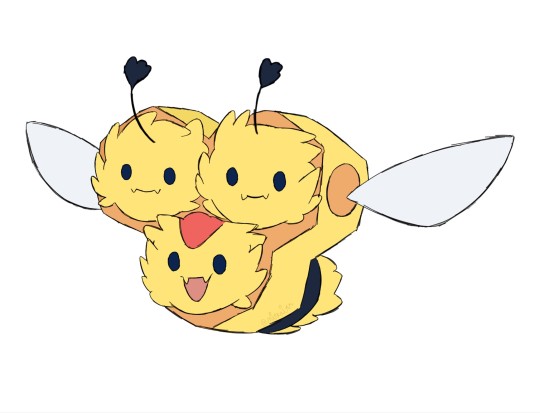
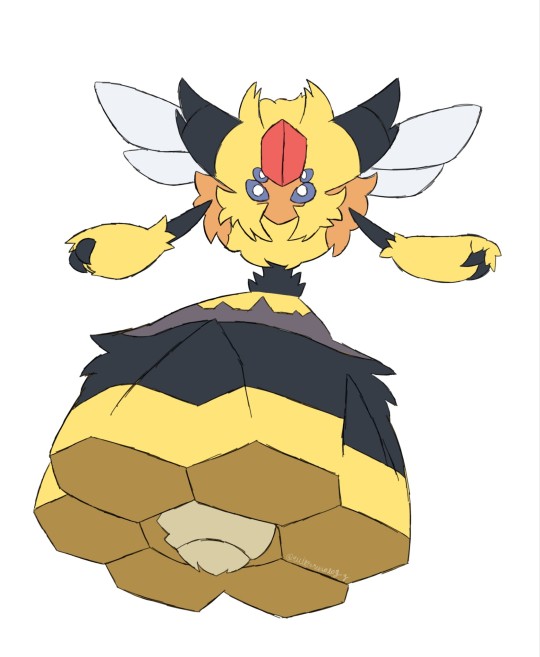
Combee

Because Vespiquen often see other bugs as enemies, crossbreed combee are often driven out of their hives. This isn't that bad for female Combee, who are better suited to be by themselves, but it's often a bigger problem for male combee who rely on others to survive. This breeds fluffy bodies help them carry more pollen, which is good if they're living on their own.
Vespiquen

Bumblebee Vespiquen have similar behaviors to standard Vespiquen, but they tend to be more gluttonous and aim for prey instead of just eating honey. Since Vespiquen have a natural instinct to lead, the ones that were driven out of hives tend to find other lone Combee and make hives with them. Hives that are run by crossbreed Vespiquen tend to have a smaller population but are more tight-knit and accepting of new members.
Anyways, Vespiquen. Like Galvantula, these Vespiquen will set traps to catch mon that come by. The hives they make can also often resemble spider webs as well.
//My designs can be used by anyone of you credit me!
#//dw im doing the other crossbreeds#//this was just in my drafts and i decided to finish it#crossbreed pokemon#pokemon crossbreeds#combee crossbreeds#vespiquen crossbreeds#galvantula#combee#vespiquen#pokemon biology#pokemon biologist#pokemon variants#bug type#bug type pokemon#bug types#flying type#flying type pokemon#flying types#rotomblr#pokemon irl#pokeblogging#pokeblog#irl pokemon#pokemon#pokeblr#rotumblr#pkmn irl#pokemon roleplay#pokeblogging roleplay#pokemedia
609 notes
·
View notes
Note
Hello! Trainer from Alola here, big fan of your work. I was wondering; is there any evidence of any legendary pokemon being related to other pokemon? For example, does Rayquaza share any DNA with other dragon pokemon? (I know it would be extremely difficult to get any rayquaza DNA fhshfjd) Or are pokemon like that entirely their own species?
the answer is, as with many things on this blog.. it depends!
"legendary pokemon" aren't really a cohesive category like, say, a type or a taxonomic group. the only common factors are that they tend to be very rare and that they have legends about them. as our examples, let's use two groups of hoenn legendary pokemon: latios and latias, and groudon, kyogre, and rayquaza.
latios and latias (like other pairs such as nidoqueen and nidoking, or volbeat and illumise, latios and latias are sexually dimorphic members of the same species) are indeed related to other pokemon- they're birds! specifically, they're in the auk family, which are a group of generally stout, seafaring birds like guillemots and puffins. this may seem strange- the latis appear to have wings and arms, and no legs, very unlike birds. however, if we take a look at their skeleton, the connection becomes much more obvious:

what we generally interpret as arms are actually the lati's legs, the thighs of which are obscured by flesh and feathers. while they use their wings to steer and for some lift, the latis generally stay aloft with their psychic powers rather than traditional flight, which is why they can hover in place. this has freed up their legs for use in manipulating objects, and they are rarely seen standing on their feet. because they mostly rely on hovering, their legs no longer have the strength to hold their large bodies up for very long.
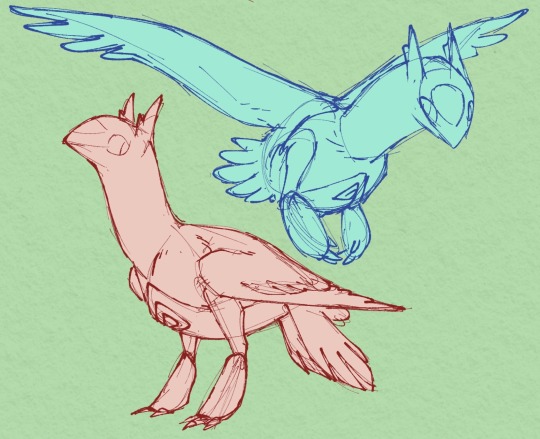
these pokemon are indeed exceptionally rare, having very low population numbers in only a few regions, and spending most of their time over open ocean. like many pelagic seabirds, they breed on only a few small islands, like alto mare off the johto region and southern island off hoenn's south coast. their populations are on the upswing, though, in large part due to concentrated conservation efforts on those islands. point being, though, they are indeed just animals. rare, powerful animals, but animals nonetheless.
many legendary pokemon fall into this camp. articuno, zapdos, and moltres, lugia and ho-oh, heatran, and various others.
.
conversely, the so-called weather trio of hoenn: groudon, kyogre, and rayquaza. these three are even more rarely seen than the latis, only having been sighted in recent times during their clash in hoenn nearly two decades ago. despite the three's resemblance to other living pokemon, as far as we know they are entirely unrelated to any known animals, or even any other life on earth.
this is known because evidence of these pokemon have been found dating back over 3 billion years ago, that is to say over a billion years before multicellular life even existed. gigantic fragments of footprints attributed to groudon have been sighted alongside some of the earliest fossils we know of of early bacteria. modern physical samples from these pokemon- the extremely few that have ever been recovered- have never resulted in any dna evidence, and appear in structure much more similar to inorganic matter.
as it stands, it appears these pokemon arose some time early (relatively speaking) after the earth formed, being (as opposed to natural living organisms) animate representations of the forces of nature themselves. a similar condition is often assumed for some other grandiose legendary pokemon, such as dialga and palkia, though much less tangible evidence exists for their presence in prehistoric time, so this is mostly an assumption based on their infrequent appearances & legends surrounding their origins.
427 notes
·
View notes
Note
Please tell me that spoink don't actually die when they stop bouncing I cannot believe the Pokedex on this one how would they possibly adapt to do that
that is indeed how they keep their blood pumping. the way their anatomy is set up, they need the force of hitting the ground to pump their blood through their whole body. it's just how they evolved! they don't need much deep sleep, and when they do sleep, their metabolism slows so drastically that they're able to get by without bouncing for a few minutes. it sounds impossible to us, but pokemon can do a lot of really incredible things!
as for why they would develop that way- it's actually a pretty energy-efficient method of moving, and the spoink can act as its own external force on its springy tail. it's also really hard for a lot of predators to predict that movement! in a competitive world with a lot of unique challenges to face, finding whatever way you can to survive means that you can develop some odd skills.
187 notes
·
View notes
Text
on object sleeping habits
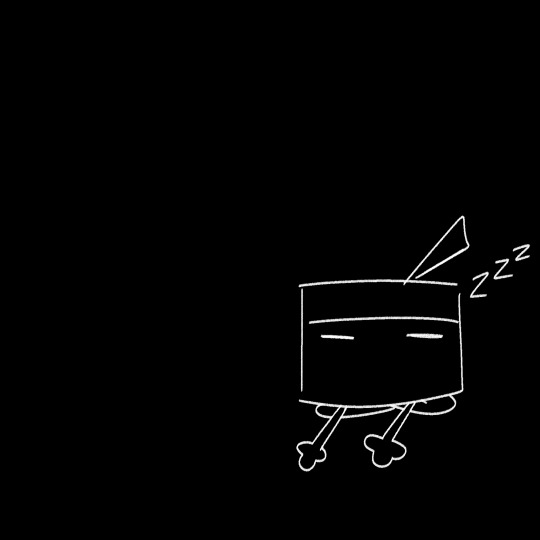

(image ID: a doodle of amelia from ONE on a black background, drawn with white outlines sleeping upright with her legs tucked underneath her and her arms laid out in front of her. the second picture shows airy next to her in the same position, legs tucked underneath him, waking her up. /end ID)
something that has been very heavily debated in the community are object sleeping habits, how they sleep, the science behind it or whether they even need to sleep at all. this post aims to go a little more in depth about it, though it won't cover everything.
for one, the anatomy and biology differs wildly between families and even individual object species. this of course affects their sleeping habits and even their circadian rhythm.
with people and animals, the way they sleep is much more obvious. humans are granted the freedom of sleeping comfortably on their backs or curled up on their sides without much issue (aside from certain health complications that may arise due to the condition(s) an individual might have.) many mammals sleep curled up, or on their sides. birds sleep with their heads tucked in their wings, or in flight if you're a swift. bats hang upside down and horses can sleep standing up on lying down. crocodiles shut off one part of their brain in order to keep a lookout or maintain flight. swifts remain in the sky for most of their lives and only ever land due to sickness or to nest, which means they fly in their sleep too. so this begs the question, how do objects sleep?
it's different for every species. due to their wild differences in anatomy as discussed earlier, they often have to learn unique adaptations that help them thrive. this extends to sleep as well. for the longest time, it was thought that objects did not need to sleep at all, though recent observations have shown otherwise. it wouldn't be feasible to cover every object's sleeping habits and patterns, so i'll be going into some more recent studies.
for one, as with the images above, objects that have flat bases or rounded bodies may find laying on their backs or sides difficult or uncomfortable. these objects sleep with their legs tucked underneath them, sitting upright or leaned against a wall or other surface. occasionally they may be found laying down if it is comfortable, but it is not often.
it also isn't uncommon to see boxes dozing off within seconds, limbs tucked beneath them, or for coins to flop onto their backs. both of these objects have body structures that compromise their abilities to rest comfortably in any other position.
objects that have a tendency to roll, like glasses or cylindrical shaped objects may rest on their backs or sides with their arms propped up by their elbows, providing a stop to keep them in place. these species tend to be very light sleepers as well, so that in the event of a threat they can awaken quickly and spring upright. this especially applies to glass objects, who exhibit unihemispheric sleep in order to remain vigilant (in other words, they sleep with only one part of their brains at a time). they are also prone to night terrors, and tend to sleep in groups that alternate between keeping watch.
#hfjone#hfjone airy#hfjone amelia#speculative biology#object shows#object sentience#unreality#object biology#yeah this is a bit of a longer one#blame pokemon sleep for making me think about this#object irl
170 notes
·
View notes
Text
What Pokémon job did you want to do as a kid or did we all want to be marine Pokémon biologists
#I wanted to do it until I found out I needed geography and biology#I hate geography and biology is gross#so performance it was!#pkmn irl#irl pkmn#unreality#tw unreality#pokemon#pokemon performer sam
158 notes
·
View notes
Note
HOW DO YOU VACCINATE A ROCK TYPE?!?!?!
quickly and carefully haha!
despite what the typing may suggest, not all rock types* are made of rock, and most of our residents are in fact covered in either a mix of scales or finely-overlapping feathers, which you can inject between
as for something like a roggenrola…yeah, well, you may have to convince the lil guys to take something orally, much like our Hoenn fossils (whose biology is a little more tricky to just inject)
*i was actually going to add an addendum about fossil rock-typing but it turned out to be a bit lengthy so imma make a separate post for it lol. in the meantime here's my boy very excited that i bought him a massive chew bone for sitting so nicely for vaccines
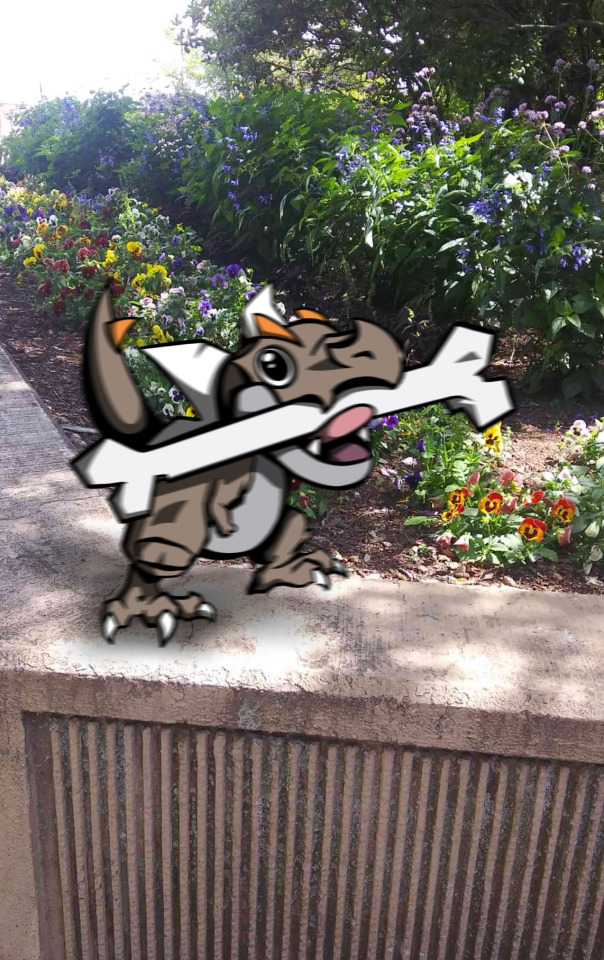
#pokemon irl#pokeblogging#rotomblr#fossil pokemon#pokemon biology#prforiginal#tyrunt#i have no excuse i've just been procrastinating answering this rip. defo a me problem dw keep sending asks if u want!!
17 notes
·
View notes
Text
The urge to scream today is getting stronger gang 👍👍
#whyyywhywhwywhy am i getting flashbacks to biology now with the. mitosis#doesnt help its related to reuniclus :(((( and solosis :((#dash commentary#pokemon irl#pkmn irl#pokeblr#pokeblogging#rotomblr#quark posting#//<- hehe
8 notes
·
View notes
Text
Kabuto have a long and extensive fossil record, dating its development and evolution throughout prehistory. One of the most amazing variations among Kabuto is the eyes, which have a great many variations and changes.
The earliest Kabuto fossils revealed crescent-shaped lenses. These lenses allowed it a spectacular range, allowing it to scan its surroundings at nearly 360 degrees around it. These lenses lasted about 50 million years.
The variations afterward are of an astounding volume. Some Kabuto were found with eyestalks! These fossils were not complete enough to be revived reliably, but a handful of revived eyestalk Kabuto are owned by researchers. Eyestalks give it a better field of view, extending its sight outside of its shell. This gives Kabuto a better view above it. Eyestalks also meant Kabuto could bury themselves under the sand and still have full view of the ocean around it.
The standard Kabuto revived from fossils are all but standard. These Kabuto have some of the most advanced optics of any Pokemon, living or extinct! Many, many lenses are stacked on each other, ranging from 10 to an impressive 50. This gives Kabuto a particularly vivid view, one that humans can not even properly percieve! Kabuto with stacked lenses see the world in excessive detail and in a vibrant array of colors.
The later fossils show two distinct types of eyes. These reflect the environment Kabuto live in, either the deepest depths of the ocean or on the shallow shores.
For the Kabuto in shallow waters, their eyes developed a stack of over 200 individual lenses. That is an insane amount of detail for such a little guy!
In the complete opposite spectrum, Kabuto living in the deep sea lost nearly all of their lenses. They were practically blind! Their eyes also got much smaller as a result, as they had little need for strong vision.

(OOC: Most information here was adapted from this article on trilobite eyes. Its a fascinating read if you have the time, and it has pictures!)
28 notes
·
View notes
Text
Hey to all of the shelters and biologists. I have a quick question about a pokémon I have in my care. (I think I've sent a question to someone already but I'm gonna make a post anyways for more opinions)
So, my family lives in Sinnoh and I'm from Galar for context. I go to school in Paldea.
My family has a Garchomp that my great grandfather raised, and after his passing it was decided that the pokémon would be allowed to choose their new trainer. On my most recent visit to Sinnoh, I actually met the big guy and we got along well.
Long story short, I'm now this big guy's new trainer. The Garchomp's name is Emperor so I'm gonna call him that from now on.
I have a lot of experience with dragon type pokémon, so caring for a Garchomp isn't gonna need too much new items, but the thing is, Emperor is REALLY big.
Like, two or three times the size of a regular Garchomp.
I don't know if this is a normal thing among Sinnohan Garchomp, and researching online isn't giving me much to go off of. Although Emperor has a clean bill of health (and was deemed battle-ready) I'm not having him participate in any battles.
So my question is does anyone know why Emperor is so large? And does that pose any health risks that I should look out for.
#pokemon#pkmn irl#rotomblr#pokemon irl#pokémon irl#garchomp#Emperor gets along with my team!! So don't worry about that#He's a very mellow old man of a Garchomp#He's also in a REALLY weird pokeball#pokemon biology#pokemon care
8 notes
·
View notes
Text

Something I doodled a few years ago, while I was living in a country that had actual winters. My buddy Sceptile on his sleeping post in the corner, underneath a heat lamp. Grassy reptiles need to stay warm on cold nights, after all :D
#fanart#fan art#my stuff#my art#pokemon#Sceptile#Pokemon worldbuilding#Pokemon art#old stuff#Pokemon irl#Pokemon biology#Pokemon science
77 notes
·
View notes
Text
Meltan & Melmetal
Meltan (#808)
Galliumvitae singula
General Information: Meltan is a Pokémon composed of gallium and bits of solidified metal parts. They are entirely composed of inorganic substances.
Meltans are tiny Pokémon, averaging at about 8 inches (0.2 M) tall and weighing 17.6 pounds (8 kg).
Habitat: Meltans can be found around natural deposits of metal ore.
Life Cycles: Meltans have one of the strangest life cycles known to Pokemonkind. Their reproductive habits are more akin to that of certain slime molds, than anything animalian—which is to say, completely alien to our notions of how reproduction should work. To start, Meltans are born when they break off from a Meltan—this process does not harm the Meltan.
A Meltan will remain as a Meltan for a long time, living in a herd of other Meltans. Eventually, one of these Meltans will become stronger than the rest and when it is strong enough, will absorb its herdmates to become a Melmetal. This process is consensual. A Meltan can become a Melmetal starting at level 45, but it must absorb other Meltans in the process or no evolution will occur. Ideally, a Melmetal has at least five Meltans, but they can be made using fewer individuals. The biggest reason it’s better to have more Meltans than fewer, is because the Melmetal stage is effectively the “sporangia” phase of the Meltan/Melmetal lifecycle. Like with certain slime molds, the individual Meltans combine their magicks to form a bigger cohesive unit. Inside the Melmetal is the individual magicks of each Meltan that composes it, and from there these energies combine and mix together to create new Meltans, which eventually separate from the Melmetal and become its own unique entity. A Melmetal can reproduce for as long as it is alive and has the stored magic to dedicate to this task. However, unlike a slime mold, Melmetals are unable to “devolve” back into the original Meltans that composes it. The decision to become a Melmetal is permanent, as is all Evolution, no matter how foreign it may be.
Meltans can be eaten by any Pokémon that would find a living amalgamation of gallium and a hex nut to be delicious.
Behavior: Meltans are social creatures that rely on their herd for survival. They are shy but sociable, who stick together tightly with their herd.
Diet: Meltans serve the absolutely vital function of being the scavengers and up-cyclers of the Metal Pokémon Food Web. They eat the scraps of metal leftover from the bodies of dead steel-type Pokémon, scavenging kills as big as Aggrons and Metagrosses even.
Conservation: Unknown, suspected to be Least Concern
Relationship with Humans: Scientists have no idea where Meltans come from. Are they Earthlings? Are they even from our dimension? Who knows! But Meltans and Melmetals have been around for so long that the ancients spoke of them. The line is so unlike any other Pokémon that scientists know of that live on Earth, that they are held to an entirely different kingdom of life (or higher, depending on who you ask) than all other Pokémon, even the Living Minerals Kingdom. Meltans are strange alien-seeming creatures living amongst us, quietly scavenging metal parts and ores. There is great ecological interest in Meltans for their role in the poorly-understood Metal Pokémon Food Web.
Classification: The genus name “Galliumvitae” simply means “Living Gallium.”

Melmetal (#809)
Galliumvitae multipula
General Information: Melmetal is the evolved form of Meltan. It is a strange Pokémon of mysterious origin, but like all life forms, it must repair and rejuvenate its body: when this happens, metal shards and flakes will fall from its body. Like its pre-evolution, Melmetal can stretch its liquid body and utilizes centrifugal force to deliver devastating punches.
Melmetal has a Gigantamax form.
Melmetals average at 8’2 feet (2.5 M) tall and weigh around 1,763.7 pounds (800 kg). The Gigantamax Melmetal is around 82+ feet (25+ M) tall.
Habitat: Melmetals can be found around metal ore deposits, or other places with lots of metal scraps and debris.
Life Cycles: See Meltan.
When a Melmetal dies of internal issues (ie: “natural causes”, “old age”, etc.), its body will rust (when applicable) and shatter. From the shattering of its gallium body, it creates Meltans one last time.
There is not much that predates upon Melmetals, and it is mostly creatures like Dusknoirs. A Melmetal could die of starvation or battle injuries, or even truly just old age. The death of a Melmetal is not common, for these creatures have no known upper limit on age, but it does happen eventually. Melmetals composed of more Meltans live longer than the ones composed of fewer, and in death its shattered metal body will produce more Meltans than a Melmetal made of fewer Meltans would.
Behavior: Melmetals are strong, stoic, but gentle giants of the mountains and forests. They may assist the Meltans nearby in their search for metal ores, utilizing their great fists to smash apart boulders for the little guys.
A fascinating thing about Melmetals, is that while they act like a single organism, they are still composed of multiple entities, who must agree on a course of action. This can cause delays in a Melmetal who experiences great confliction, and a Melmetal with more Meltans inside it may be slower to decide on a course of action. This is why Melmetals are notoriously very slow Pokémon—though their size doesn’t help.
Diet: Metal. No one is sure how a Melmetal (or Meltan) can eat any type of metal, when that’s a huge range of elements, nor how its body is able to convert that metal into energy or into gallium specifically. The ways of the Metal Pokémon Food Web are mysterious, but it is worth noting that the hard parts of a Melmetal can be composed of many different metals, depending on what its been eating.
Conservation: Unknown
Relationship with Humans: Melmetals have been scavengers of metal for ages, and humans have loved them for their ability to seemingly produce metal from nowhere. The non-living metal bits that fall off of Melmetals have been used in tool making for thousands of years… well, we’re assuming it’s only the non-living bits. Personally, I wouldn’t put it past some ancient peoples to melt down a Meltan and use its melted corpse for black/silver-smithery.
In modern times, some municipalities have implemented a Melmetal to clean up their metal “recycling”—the stuff that people throw in the recycling bin in earnest but will never actually be recycled for one stupid reason and that. Have no fear! Melmetals will eat them for you 😊
Classification: The species epithet of Melmetal is “multipula” which means “multiple.” This refers to the fact that Melmetals are actually a composite organism.
Evolution: See Meltan’s life cycle for explanation.

~~~~~~~~
Hey guess what, if you like my stuff, this is my website where you can find other Pokémon I've written on and more information about the game that I’m slowly making! Check it out! I write books sometimes too.
#meltan#melmetal#pokemon#pokemon biology#homebrew#ttrpg#pokemon biology irl#pokemon tabletop#tabletop#tabletop homebrew#pokemon irl#pokemon biology irl tabletop#pokemon go#pokemon gen 7#gen 7 pokemon#pokemon let's go#pokemon lgpe#pokemon let's go pikachu and eevee#gen 7
8 notes
·
View notes
Text
Pokemon Crossbreeds: Thief
(An Anon asked me to do this crossbreed, but tumblr won't let me edit posts if it's an ask)
Thief is the name for Zorua/Zoroark with a Nickit/Thievul father. They were named after the masks they have gained and their willingness to steal. The Hisuian variant isn't found in the wild due to Thievul and Zoroark living in very different time periods and climates.

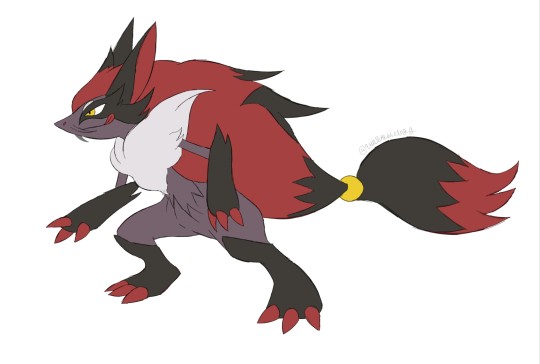
Zorua

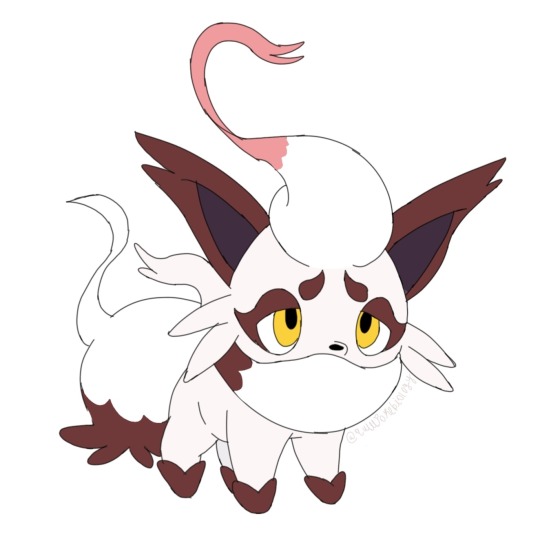
Theif Zorua gain darker colored patches if fur, larger eye markings and more curved eyebrows, larger and more pointed ears, fluffier tails, yellow eyes, and special pads on their paws that keep them silent when stalking. They're braver than standard Zorua, actively going up to travelers to steal from them.
Zoroark

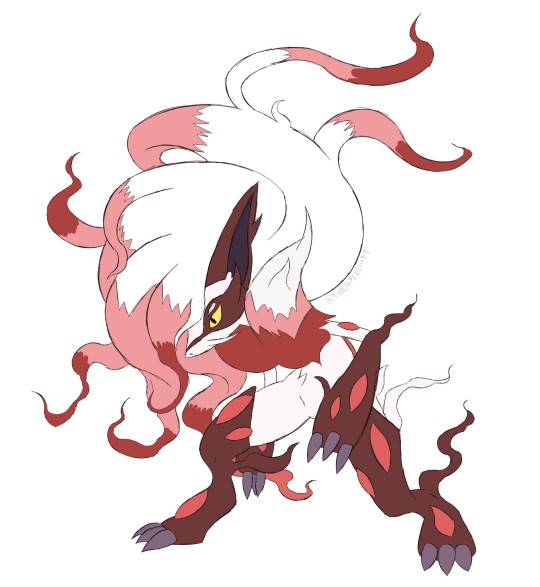
Theif Zoroark gain the masks of Thievul, as well as the longer whiskers. They are feared more than standard Zoroark because, unlike standard Zoroark who will create terrifying illusions to keep people away from them, this form of Zoroark will actively follow humans if they have something they want, creating scary illusions until they're close enough to steal it.
//My designs can be used by anyone!
#pokemon crossbreeds#crossbreed pokemon#zoroark crossbreeds#zoroark variants#pokemon variants#rotomblr#pokemon irl#pokeblogging#pokeblog#irl pokemon#pokemon#pokeblr#rotumblr#pkmn irl#pokemon roleplay#irl pkmn#pokemon biology
339 notes
·
View notes
Text
Did You Know? Possible Biological Functions of Pawniard, Bisharp, and Kingambit Color
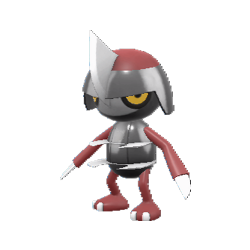


Ever wondered about Pawniard, Bisharp, and Kingambit’s colors? While much of their bodies here are actually a few hypotheses that could potentially explain the red armor parts, and why those are dull compared to the rest.
The red color may help individuals find each other, because Pawniard’s evolutionary line has eyesight as sharp as the blades on their bodies. This may be useful while hunting together or seeking more Pawniard to join a group; but not so much when two Bisharp cross paths, with a possibility of one eating the other.
The dullness of the red parts likely makes Pawniard’s line less visible to other unrelated Pokémon among greenery, especially in the shade. While their main ungulate prey species don’t have discernible color vision between red and green, most bird Pokémon can distinguish these colors as well as a broader range than humans.
Kingambit presents another complicated matter, as its increased gold-colored pigmentation, towering oversized head blade, and additional long “mustache” blades make it quite a sight to behold. This is all an obvious evolutionary show-off, but has made Kingambit give up stealth altogether and rush into battle with only sheer numbers of its pre-evolutions as its advantage. Kingambit has also gained some areas of bright red pigmentation, while retaining the dull red of Bisharp.
All in all, there appears to be a trade-off between visibility and camouflage among Pawniard, Bisharp, and Kingambit; which is still not well understood. Anyone have any other hypotheses of your own? If you do, feel free to propose them in the comments here!
#pokemon#pawniard#bisharp#kingambit#generation 5 pokemon#generation 9 pokemon#dark type pokemon#steel type pokemon#pokemon biology#pokemon irl#pkmn irl#pokemon blogging#pokemon blog#pkmn blog#did you know#pokedex#pokeblogging
13 notes
·
View notes
Note
My mom gave me a large pot of dirt like a week ago and a baby Bulbasaur just crawled out of it today. Is this. Is this normal??? Do they bury their eggs?
they do! mama bulbasaur dig holes in soft soil to lay their eggs in, then cover the eggs up so they're kept warm for incubation. when the babies hatch, they slowly dig their way out while absorbing nutrients from the soil until they break out and can start photosynthesizing.
if that dirt was for gardening, a garden bulbasaur can be a great pokemon to have around. their dung makes fantastic plant food! but if you're not looking for a pokemon right now, you can take the little guy to any pokemon drop-off location to be rehomed, released, or sent to a shelter.
104 notes
·
View notes
Text
The Biology of Walking Wake Pt1
Walking wake is a newly discovered pokemon from the Paldea region. A claimed “legendary” paradox. Some sort of past version of the one of Three Reborn.
This is just chalked up to the fact that this creature's adaptions make it a very much like Suicune in looks and some behaivours, such as water walking.
This is because Walking Wake is a dedicated piscivorous ambush predator. Every part of its biology makes it perfect at catching fish from above.
The chompers.
These might look like teeth, but they're actually a highly modified beak. Walking Wake is a toothless animal. This solid beak structure gives the animal the ability to quickly dispatch its prey by cutting it in half. These are constantly growing and the shearing motion sharpens them to a blade-like point.
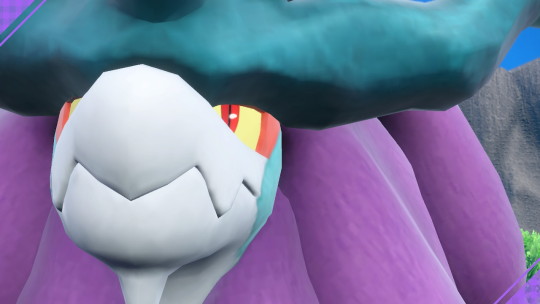

The mane gives it the ability to cast a wider shadow, actually attracting fish to it. It can flex this mane as it leans over watching for its next meal. If it stays still long enough the fish seek it out, thinking it might be shelter.
Note the slender arms. These arms are great at grabbing a wriggly fish. They can be used both to cage a fish or to impale it. Proteus prefers impaling.

The long legs put it high up above the water, giving its prey less to notice and the slenderness of them allow the creature to move carefully and slowly. Even the leg fluffs help break up its shadow.
I'm still studying what the twin tails might be but I do have some theories.
@official-raihan thought you'd like to see this. If you wanna meet Proteus swing by my booth where I have everything set up. Though be warned there's a fair crowd.
#pokemon irl#dragon con pkmn irl#Walking Wake#Pokemon biology#pokemon headcanon#scarlet violet spoilers#pokemon#professor hemp#Proteus the Walking Wake#pokeblogging#pokemon rp
39 notes
·
View notes